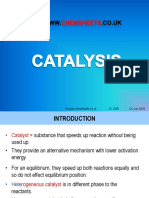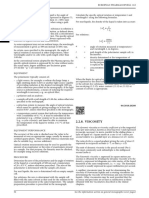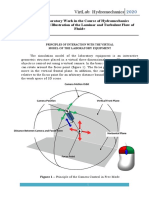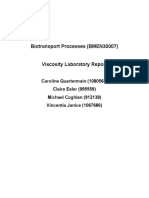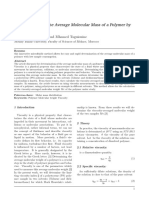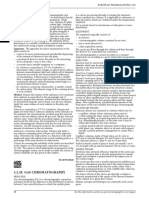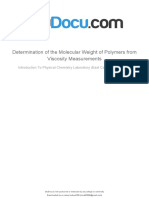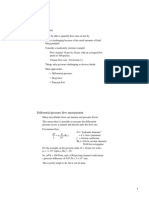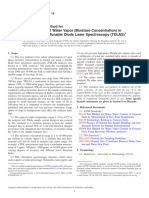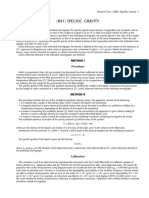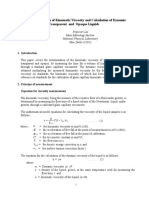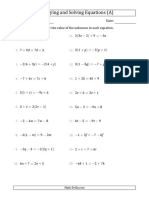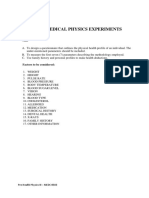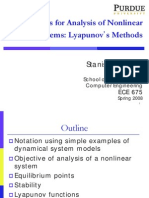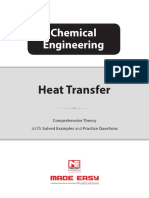0 ratings0% found this document useful (0 votes)
75 views2.2.9 Capillary Viscometer Method
2.2.9 Capillary Viscometer Method
Uploaded by
Lance ShahThis document provides information and procedures for measuring viscosity using a capillary viscometer method. It describes the key components of an Ubbelohde-type capillary viscometer and the principle of determining viscosity by measuring the time it takes a liquid's level to drop between two marks in the viscometer at a controlled temperature. The document outlines the equipment, procedures for taking measurements, and equations for calculating kinematic and dynamic viscosity from the measured flow time.
Copyright:
© All Rights Reserved
Available Formats
Download as PDF, TXT or read online from Scribd
2.2.9 Capillary Viscometer Method
2.2.9 Capillary Viscometer Method
Uploaded by
Lance Shah0 ratings0% found this document useful (0 votes)
75 views2 pagesThis document provides information and procedures for measuring viscosity using a capillary viscometer method. It describes the key components of an Ubbelohde-type capillary viscometer and the principle of determining viscosity by measuring the time it takes a liquid's level to drop between two marks in the viscometer at a controlled temperature. The document outlines the equipment, procedures for taking measurements, and equations for calculating kinematic and dynamic viscosity from the measured flow time.
Original Title
2.2.9 CAPILLARY VISCOMETER METHOD
Copyright
© © All Rights Reserved
Available Formats
PDF, TXT or read online from Scribd
Share this document
Did you find this document useful?
Is this content inappropriate?
This document provides information and procedures for measuring viscosity using a capillary viscometer method. It describes the key components of an Ubbelohde-type capillary viscometer and the principle of determining viscosity by measuring the time it takes a liquid's level to drop between two marks in the viscometer at a controlled temperature. The document outlines the equipment, procedures for taking measurements, and equations for calculating kinematic and dynamic viscosity from the measured flow time.
Copyright:
© All Rights Reserved
Available Formats
Download as PDF, TXT or read online from Scribd
Download as pdf or txt
0 ratings0% found this document useful (0 votes)
75 views2 pages2.2.9 Capillary Viscometer Method
2.2.9 Capillary Viscometer Method
Uploaded by
Lance ShahThis document provides information and procedures for measuring viscosity using a capillary viscometer method. It describes the key components of an Ubbelohde-type capillary viscometer and the principle of determining viscosity by measuring the time it takes a liquid's level to drop between two marks in the viscometer at a controlled temperature. The document outlines the equipment, procedures for taking measurements, and equations for calculating kinematic and dynamic viscosity from the measured flow time.
Copyright:
© All Rights Reserved
Available Formats
Download as PDF, TXT or read online from Scribd
Download as pdf or txt
You are on page 1of 2
EUROPEAN PHARMACOPOEIA 10.0 2.2.9.
Capillary viscometer method
In the conventional system adopted by the Pharmacopoeia, the
specific optical rotation is expressed by its value without units ;
the actual units, degree millilitres per decimetre gram When the limits for optical rotation or specific optical rotation
[(°)·ml·dm− 1·g− 1] are understood. are expressed as the dried substance, the anhydrous substance
or the solvent-free substance, the result must be corrected for
EQUIPMENT loss on drying (2.2.32), water content (2.5.12 or 2.5.32) or
The polarimeter typically consists of : content of solvent as appropriate.
– a light source, for example a sodium discharge lamp, a
light-emitting diode (LED) or another light source capable
of providing radiation at the desired wavelength (589 nm
unless otherwise prescribed in the monograph) ; if the light
source is polychromatic, a means of isolating the required
wavelength is necessary, e.g. an optical filter ; 04/2018:20208
– a polariser and an analyser ;
– a sample cell with a path length of 1.00 dm, unless otherwise
specified in the monograph ;
– a detection system to measure the angle of optical rotation,
which must be capable of giving readings to at least the 2.2.8. VISCOSITY
nearest 0.01°, unless otherwise specified in the monograph ;
– a temperature control system that indicates the temperature The dynamic viscosity or viscosity coefficient η is the tangential
with a readability of 0.1 °C ; it may be embedded in the force per unit surface, known as shearing stress τ and expressed
polarimeter (e.g. a Peltier system) or be an external unit in pascals, necessary to move, parallel to the sliding plane, a
(e.g. a cycle-cryostat), and must be able to maintain layer of liquid of 1 square metre at a rate (v) of 1 metre per
the temperature of the liquid to within ± 0.5 °C of that second relative to a parallel layer at a distance (x) of 1 metre.
prescribed.
The ratio dv/dx is a speed gradient giving the rate of shear D
EQUIPMENT PERFORMANCE expressed in reciprocal seconds (s− 1), so that η = τ/D.
The accuracy of the scale is checked near the value to be The unit of dynamic viscosity is the pascal second (Pa·s).
measured or over an appropriate range, usually by means of The most commonly used submultiple is the millipascal
certified quartz plates. Other certified reference materials may second (mPa·s).
also be suitable (e.g. sucrose solutions).
The kinematic viscosity v, expressed in square metres per
Optical rotation measurements may be used to quantify the
second, is obtained by dividing the dynamic viscosity η by the
amount of an enantiomer or the ratio of enantiomers present
density ρ expressed in kilograms per cubic metre, of the liquid
in a sample. For that purpose, the linearity must be checked,
measured at the same temperature, i.e. v = η/ρ. The kinematic
for example using sucrose solutions.
viscosity is usually expressed in square millimetres per second.
PROCEDURE A capillary viscometer may be used for determining the
Determine the zero of the polarimeter and the angle of rotation viscosity of Newtonian liquids and a rotating viscometer for
of the liquid at a wavelength of 589 nm and a temperature determining the viscosity of Newtonian and non-Newtonian
of 20 ± 0.5 °C, unless otherwise prescribed. The zero of the liquids. Other viscometers may be used provided that the
polarimeter is determined with the sample cell closed. accuracy and precision are at least as satisfactory as those
For neat liquids, the zero is determined with an empty sample obtained with the viscometers described in the related
cell. chapters.
For solutions, the zero is determined with the sample cell
filled with the same solvent as that used for the solution to be
examined and measured at the same temperature. The sample
preparation procedure is prescribed in the monograph.
Calculate the specific optical rotation at temperature t and 01/2019:20209
wavelength λ using the following formulae.
For neat liquids, the density of the liquid is taken into account :
α
[α]tλ =
l·ρt
For solutions : 2.2.9. CAPILLARY VISCOMETER
1000α METHOD
[α]tλ =
l·c
α PRINCIPLE
= angle of rotation measured at temperature t
and wavelength λ, in degrees ; The determination of viscosity is carried out using a
l = path length of the polarimeter sample cell, in suspended-level (Ubbelohde-type) capillary viscometer of
decimetres ; appropriate size at a temperature of 20.0 ± 0.1 °C, unless
otherwise prescribed. The time required for the level of the
ρt = density determined at the temperature of liquid to drop from one mark to the other is measured.
measurement t, in grams per cubic centimetre ;
for the purposes of the Pharmacopoeia, density
is replaced by relative density (2.2.5) ; EQUIPMENT
c = concentration of the solution, in grams per The principal components of an Ubbelohde-type capillary
litre. viscometer(1). are shown in Figure 2.2.9.-1.
(1) The European Pharmacopoeia describes the system proposed by the International Organization for Standardization (ISO)
General Notices (1) apply to all monographs and other texts 27
2.2.10. Viscosity - Rotating viscometer method EUROPEAN PHARMACOPOEIA 10.0
L M N closing tube N and opening tube M. Open tube N and, using a
stopwatch, measure the time required, to at least the nearest
1/5 of a second, for the level of the liquid to drop from mark E
to mark F.
The flow time of the liquid to be examined is the mean of
3 consecutive measurements. The result is valid if the relative
standard deviation of the 3 measurements is not more than
D 2.0 per cent.
E
Calculation
C Calculate the kinematic viscosity (ν) (2.2.8), in square
F millimetres per second, using the following expression :
ν = kt
k = viscometer constant, in square millimetres per second
squared ;
t = flow time of the liquid to be examined, in seconds.
Calculate the dynamic viscosity (η) (2.2.8), in millipascal
R seconds, using the following expression :
η = kρt
ρ = density of the liquid to be examined at the temperature
used for the viscosity measurement, in milligrams
per cubic millimetre.
B
The density may be obtained by multiplying the relative
density of the liquid to be examined by 0.99820 (measurement
at 20 °C) or 0.99704 (measurement at 25 °C).
A
01/2008:20210
Figure 2.2.9.-1. – Suspended-level (Ubbelohde-type) capillary
viscometer 2.2.10. VISCOSITY - ROTATING
PROCEDURE VISCOMETER METHOD
Select a capillary viscometer of appropriate size to obtain a The principle of the method is to measure the force acting on
minimum flow time of 200 s. a rotor (torque) when it rotates at a constant angular velocity
Calibration (rotational speed) in a liquid. Rotating viscometers are used
for measuring the viscosity of Newtonian (shear-independent
Capillary viscometers are calibrated at regular intervals as viscosity) or non-Newtonian liquids (shear dependent
defined in the quality management system and dictated by the viscosity or apparent viscosity). Rotating viscometers can be
frequency of use of the equipment and the application. divided in 2 groups, namely absolute and relative viscometers.
Calibrate the instrument at the temperature used for the In absolute viscometers the flow in the measuring geometry is
measurement by using at least 2 certified reference materials well defined. The measurements result in absolute viscosity
matching the viscosity range of the viscometer. values, which can be compared with any other absolute values.
Calculate the viscometer constant (k) in square millimetres In relative viscometers the flow in the measuring geometry
per second squared, using the following expression : is not defined. The measurements result in relative viscosity
η values, which cannot be compared with absolute values or
k= other relative values if not determined by the same relative
ρt viscometer method.
η = dynamic viscosity of the certified reference material, in Different measuring systems are available for given viscosity
millipascal seconds ; ranges as well as several rotational speeds.
ρ = density of the certified reference material, in milligrams APPARATUS
per cubic millimetre ;
The following types of instruments are most common.
t = flow time for the certified reference material to drop
CONCENTRIC CYLINDER VISCOMETERS (ABSOLUTE
from the upper mark to the lower mark, in seconds.
VISCOMETERS)
Calculate the mean of the values obtained. In the concentric cylinder viscometer (coaxial double cylinder
Method viscometer or simply coaxial cylinder viscometer), the viscosity
Charge the viscometer (Figure 2.2.9.-1) through tube L with is determined by placing the liquid in the gap between the
a sufficient quantity of the liquid to be examined (previously inner cylinder and the outer cylinder. Viscosity measurement
brought to 20 °C unless otherwise prescribed) to fill bulb A can be performed by rotating the inner cylinder (Searle type
while ensuring that the level of liquid in bulb B is below viscometer) or the outer cylinder (Couette type viscometer),
the exit to ventilation tube M. Immerse the viscometer in as shown in Figures 2.2.10.-1 and 2.2.10.-2, respectively. For
the upright position in a water-bath at 20.0 ± 0.1 °C (unless laminar flow, the viscosity (or apparent viscosity) η expressed
otherwise prescribed) and allow to stand for not less than in pascal-seconds is given by the following formula :
30 min to allow the temperature to reach equilibrium. Close
1 æ M ö÷æç 1 1 ö
çç 2 - 2 ÷÷÷÷ = k
tube M and draw the level of the liquid in tube N up to a level M
η= çç ÷
about 8 mm above mark E. Keep the liquid at this level by ç ÷
ω è 4πh øçè R i R o ÷ø ω
28 See the information section on general monographs (cover pages)
You might also like
- MAN Injectie Electronica EDC M.S 6.4Document63 pagesMAN Injectie Electronica EDC M.S 6.4Babei Ionut-Mihai100% (16)
- 2.2.7. Optical RotationDocument2 pages2.2.7. Optical RotationTrung Dương ĐứcNo ratings yet
- Medc 0503 2022-2023 Lab 3 - EogDocument14 pagesMedc 0503 2022-2023 Lab 3 - EogLance ShahNo ratings yet
- 841 Specific GravityDocument1 page841 Specific GravityJam SkyNo ratings yet
- 2 - 2 - 7 Optical RotationDocument1 page2 - 2 - 7 Optical RotationHưng Lữ Nguyễn Phúc100% (2)
- Astm D 1657 PDFDocument5 pagesAstm D 1657 PDFJorge Kovach AlvaradoNo ratings yet
- Chemsheets A2 1029 (Catalysis)Document17 pagesChemsheets A2 1029 (Catalysis)Jon HadleyNo ratings yet
- Johnson Cook StrengthDocument2 pagesJohnson Cook StrengthClaudio Martín GimenezNo ratings yet
- 2.2.8. ViscosityDocument1 page2.2.8. ViscosityTrung Dương ĐứcNo ratings yet
- European Pharmacopoeia Optical Rotation and Refractive IndexDocument1 pageEuropean Pharmacopoeia Optical Rotation and Refractive IndexAlejaMedranoNo ratings yet
- 2.2.9. Capillary Viscometer MethodDocument2 pages2.2.9. Capillary Viscometer MethodJalaluddin Johan100% (2)
- 2 - 2 - 6 Refractive IndexDocument1 page2 - 2 - 6 Refractive IndexHưng Lữ Nguyễn PhúcNo ratings yet
- 2.2.6. Refractive IndexDocument1 page2.2.6. Refractive IndexaymenbiogalenicNo ratings yet
- 2.2.7. Optical Rotation - European Pharmacopoeia 11.4Document2 pages2.2.7. Optical Rotation - European Pharmacopoeia 11.4MaulidyaNo ratings yet
- UV VisDocument5 pagesUV VismurniatisariNo ratings yet
- 2.2.25. Absorption Spectrophotometry Ultraviolet and VisibleDocument3 pages2.2.25. Absorption Spectrophotometry Ultraviolet and Visiblepires35100% (1)
- TGGuideline 114 Viscosity of LiquidsDocument7 pagesTGGuideline 114 Viscosity of LiquidsDonig FermanianNo ratings yet
- 2.2.25. Absorption Spectrophotometry Ultraviolet and Visible 20225eDocument3 pages2.2.25. Absorption Spectrophotometry Ultraviolet and Visible 20225eChí NguyễnNo ratings yet
- D4402 R. VescometerDocument3 pagesD4402 R. VescometerAli YousefNo ratings yet
- Experiment On Basic Concepts: Experiment 4.1 Measurement of Viscosity by Redwood ViscometerDocument5 pagesExperiment On Basic Concepts: Experiment 4.1 Measurement of Viscosity by Redwood ViscometerCamille LardizabalNo ratings yet
- Lab 1Document12 pagesLab 1yash saragiyaNo ratings yet
- VirtLab - Laminar and Turbulent Flow - ManualDocument13 pagesVirtLab - Laminar and Turbulent Flow - ManualJosé AokiNo ratings yet
- Viscosity PDFDocument2 pagesViscosity PDFNindy Dellia PutriNo ratings yet
- Diffusion Coefficient Full Report TiqaDocument19 pagesDiffusion Coefficient Full Report TiqaprmzNo ratings yet
- Practical 1 Viscosity Report (Group 35)Document31 pagesPractical 1 Viscosity Report (Group 35)Sharath BalachandraNo ratings yet
- Full Report Kinematic ViscosityDocument11 pagesFull Report Kinematic ViscosityKyle Pong100% (1)
- Appendix V F. Determination of Optical Rotation and Specific Optical Rotation - British PharmacopoeiaDocument2 pagesAppendix V F. Determination of Optical Rotation and Specific Optical Rotation - British PharmacopoeiaFarlane MtisiNo ratings yet
- Smoke PointDocument16 pagesSmoke PointSuhaib IqbalNo ratings yet
- Circular DichroismDocument2 pagesCircular DichroismgrjhbNo ratings yet
- ASTM D 2171 - 01 (Standard Test Method For Viscosity of Asphalts by Vacuum Capillary Viscometer)Document8 pagesASTM D 2171 - 01 (Standard Test Method For Viscosity of Asphalts by Vacuum Capillary Viscometer)Sudip MukhopadhyayNo ratings yet
- Cadernos de AstronomiaDocument4 pagesCadernos de AstronomiaMohamed TAGUIOUINENo ratings yet
- C92IA010EN-B Molar Mass CalculationDocument3 pagesC92IA010EN-B Molar Mass CalculationMartín PerezNo ratings yet
- Farmacopeea Europeana Ed. 10 Cap. 2. 2. 28.Document2 pagesFarmacopeea Europeana Ed. 10 Cap. 2. 2. 28.Alex-Bogdan VișaNo ratings yet
- A Is Shear Stress Momentum FluxDocument21 pagesA Is Shear Stress Momentum FluxPamela MendozaNo ratings yet
- 〈841〉 SPECIFIC GRAVITYDocument2 pages〈841〉 SPECIFIC GRAVITYVieno Gino CruzNo ratings yet
- Absolute, Dynamic and Kinematic ViscosityDocument12 pagesAbsolute, Dynamic and Kinematic Viscosityamit kumar guptaNo ratings yet
- DNA SkanIT Microplate Based Pathlength Correction Technical Note enDocument4 pagesDNA SkanIT Microplate Based Pathlength Correction Technical Note enPisey SayNo ratings yet
- L-08 (SS) (Ia&c) ( (Ee) Nptel)Document11 pagesL-08 (SS) (Ia&c) ( (Ee) Nptel)Marvin BayanayNo ratings yet
- Specific Gravity Measurement by Hydrometer: 1. TheoryDocument11 pagesSpecific Gravity Measurement by Hydrometer: 1. TheoryAhmed BubakerNo ratings yet
- Determination of ViscosityDocument8 pagesDetermination of ViscosityHonour JamesNo ratings yet
- VirtLab - Laminar and Turbulent Flow - ManualDocument7 pagesVirtLab - Laminar and Turbulent Flow - ManualStefanía Rojas AlmécigaNo ratings yet
- Lab 1 PH Conductivity TurbidityDocument4 pagesLab 1 PH Conductivity TurbiditySumit Priyam67% (3)
- Determination of The Molecular Weight of Polymers From Viscosity MeasurementsDocument10 pagesDetermination of The Molecular Weight of Polymers From Viscosity MeasurementsAbdullah MunawarNo ratings yet
- Week11 LecturesDocument40 pagesWeek11 LecturesMatteo RizzottoNo ratings yet
- Is 3025 (P-14) For ConductivityDocument4 pagesIs 3025 (P-14) For Conductivityamishraioc0% (1)
- Measurement of Kinematic Viscosity (E3)Document17 pagesMeasurement of Kinematic Viscosity (E3)Zuptha KhanNo ratings yet
- Property-Lab NazeerDocument7 pagesProperty-Lab NazeerNazeer AlyasNo ratings yet
- Cyclone Examples Calc TutorialsDocument5 pagesCyclone Examples Calc TutorialsRacquel LallieNo ratings yet
- 2.2.21. FluorimetryDocument2 pages2.2.21. FluorimetryMinh Anh NguyễnNo ratings yet
- Measurement of ViscosityDocument11 pagesMeasurement of ViscosityKarl RodernoNo ratings yet
- Chemistry - Investigation On Structure & BondingDocument8 pagesChemistry - Investigation On Structure & BondingNej SnekNo ratings yet
- Chemistry Lab ReportDocument18 pagesChemistry Lab Reportapi-341785642No ratings yet
- 2.2.35. Osmolality 20235eDocument1 page2.2.35. Osmolality 20235eeduardoNo ratings yet
- Reverse OsmosisDocument24 pagesReverse OsmosisHyumi DarthNo ratings yet
- Intemational Journal of PharmaceuticsDocument6 pagesIntemational Journal of PharmaceuticsHelen JullsNo ratings yet
- Determination of Water Vapor (Moisture Concentration) in Natural Gas by Tunable Diode Laser Spectroscopy (TDLAS)Document7 pagesDetermination of Water Vapor (Moisture Concentration) in Natural Gas by Tunable Diode Laser Spectroscopy (TDLAS)asmaNo ratings yet
- Specific Gravity PDFDocument2 pagesSpecific Gravity PDFTrishaRaquepoNo ratings yet
- GATE - 13 - Mech - Fluid Mechanics - V.venkateswarluDocument97 pagesGATE - 13 - Mech - Fluid Mechanics - V.venkateswarluVenkateswarlu VelisalaNo ratings yet
- Viscosity of LiquidsDocument7 pagesViscosity of LiquidsHi Tech Calibration ServicesNo ratings yet
- Iso 6157 1 1988 PDFDocument17 pagesIso 6157 1 1988 PDFfavel_fNo ratings yet
- Liquid Vis Cos I TiesDocument7 pagesLiquid Vis Cos I TiesGabriella WidjajaNo ratings yet
- Is 1448PT 32Document23 pagesIs 1448PT 32RAKESH SRIVASTAVANo ratings yet
- Analytical Modeling of Solute Transport in Groundwater: Using Models to Understand the Effect of Natural Processes on Contaminant Fate and TransportFrom EverandAnalytical Modeling of Solute Transport in Groundwater: Using Models to Understand the Effect of Natural Processes on Contaminant Fate and TransportNo ratings yet
- Employee'S Declaration of Emoluments, Deductions and Tax CreditsDocument3 pagesEmployee'S Declaration of Emoluments, Deductions and Tax CreditsLance ShahNo ratings yet
- Onlineservice-Authorization Letter To Use Utilty BillDocument1 pageOnlineservice-Authorization Letter To Use Utilty BillLance ShahNo ratings yet
- Algebra Linear Equations Combining Terms Solving 001.1614301720Document2 pagesAlgebra Linear Equations Combining Terms Solving 001.1614301720Lance ShahNo ratings yet
- Part-Time Claim Form (MEDC 0501 2022-23)Document2 pagesPart-Time Claim Form (MEDC 0501 2022-23)Lance ShahNo ratings yet
- Medc 0503 2022-2023 Lab 2 - CroDocument10 pagesMedc 0503 2022-2023 Lab 2 - CroLance ShahNo ratings yet
- Measurements Lab Final-2Document19 pagesMeasurements Lab Final-2Lance ShahNo ratings yet
- EOG Lab 3 Zwade CompletedDocument18 pagesEOG Lab 3 Zwade CompletedLance ShahNo ratings yet
- Medc 0503 2022-2023 Lab 5 - Field TripDocument2 pagesMedc 0503 2022-2023 Lab 5 - Field TripLance ShahNo ratings yet
- Phys 0100 ArchimedesDocument4 pagesPhys 0100 ArchimedesLance ShahNo ratings yet
- MEDC 0501 Lab 2 ViscosityDocument12 pagesMEDC 0501 Lab 2 ViscosityLance ShahNo ratings yet
- MEDC 0503 2022-2023 LAB 1 - Medical ExperimentsDocument1 pageMEDC 0503 2022-2023 LAB 1 - Medical ExperimentsLance ShahNo ratings yet
- Lecture 4 Experimental Design 18.9.18NDDocument16 pagesLecture 4 Experimental Design 18.9.18NDLance ShahNo ratings yet
- Lab 5 - Archimedes PrincipleDocument13 pagesLab 5 - Archimedes PrincipleLance ShahNo ratings yet
- Lab 4 Write UpDocument3 pagesLab 4 Write UpLance ShahNo ratings yet
- Elasticity and Oscillations Mark SchemeDocument2 pagesElasticity and Oscillations Mark SchemeLance ShahNo ratings yet
- Industrial Shredder MODEL K 13/50: Instruction Manual For Use and MaintenanceDocument153 pagesIndustrial Shredder MODEL K 13/50: Instruction Manual For Use and MaintenanceJosé Noel Terreros Blanco100% (1)
- Viral Traning ReportDocument56 pagesViral Traning ReportbananosnetNo ratings yet
- Monitoring Ug Geotech PtfiDocument32 pagesMonitoring Ug Geotech Ptfimaruko100% (2)
- 1 s2.0 S0141029606003269 MainDocument20 pages1 s2.0 S0141029606003269 MainEdwardAlbertoQuirozRojasNo ratings yet
- Assignment 3Document3 pagesAssignment 3Vandit GoyalNo ratings yet
- Stereographic ProjectionDocument14 pagesStereographic ProjectionAdrian Salcedo ChiticaNo ratings yet
- Lyapunov TutorialDocument104 pagesLyapunov Tutorialrin9100% (2)
- Heat Transfer THDocument14 pagesHeat Transfer THKalil BashaNo ratings yet
- Quantum Dot Single-Photon Source: Prospects For Applications in Quantum Information ProcessingDocument23 pagesQuantum Dot Single-Photon Source: Prospects For Applications in Quantum Information ProcessingAvinash Kumar SrivastavaNo ratings yet
- Cryo Derm ENG 1Document15 pagesCryo Derm ENG 1beaumedicNo ratings yet
- PHYSICS Class 12 ProjectDocument11 pagesPHYSICS Class 12 ProjectHanin ThariqueNo ratings yet
- Salted EggDocument25 pagesSalted EggAngelica DuevoNo ratings yet
- ImplosionDocument134 pagesImplosionAmanat Hossain SumonNo ratings yet
- TRONIXDocument11 pagesTRONIXAldrin Baquilid FernandezNo ratings yet
- Nanocomposite PDFDocument16 pagesNanocomposite PDFRahul YadavNo ratings yet
- Molecular Orbital TheoryDocument14 pagesMolecular Orbital TheoryElectro_LiteNo ratings yet
- 9701 m16 Ms 33Document5 pages9701 m16 Ms 33Abrar AhmedNo ratings yet
- Publications of Paul ErdösDocument70 pagesPublications of Paul ErdöszhazzuNo ratings yet
- Kinetics of Fluidized Bed Iron Ore ReductionDocument8 pagesKinetics of Fluidized Bed Iron Ore ReductionMaulana RakhmanNo ratings yet
- Z04 Series TriacDocument6 pagesZ04 Series TriacAndresNo ratings yet
- A Fundamental Conundrum in Psychology's Standard Model of Measurement and Its Consequences For Pisa Global Rankings.Document10 pagesA Fundamental Conundrum in Psychology's Standard Model of Measurement and Its Consequences For Pisa Global Rankings.Unity_MoT100% (1)
- ITG43r - 07 Report On Structural Design andDocument66 pagesITG43r - 07 Report On Structural Design andHarun AlrasyidNo ratings yet
- Maintenance Component Main Function Level Activity Frequency Line DepartmentDocument7 pagesMaintenance Component Main Function Level Activity Frequency Line DepartmentBarath100% (1)
- Search Techniques Entry ExitDocument7 pagesSearch Techniques Entry ExitJavier Andres Martinez OrtegaNo ratings yet
- Design of 500lbf Methalox EngineDocument75 pagesDesign of 500lbf Methalox EngineVilim CindoriNo ratings yet
- Xi Mathematics Practical ActivityDocument30 pagesXi Mathematics Practical ActivityAdarsh Kumar PadhanNo ratings yet
- J R Rice - Path Independentt Integral - JAM68Document8 pagesJ R Rice - Path Independentt Integral - JAM68CJCONSTANTENo ratings yet






